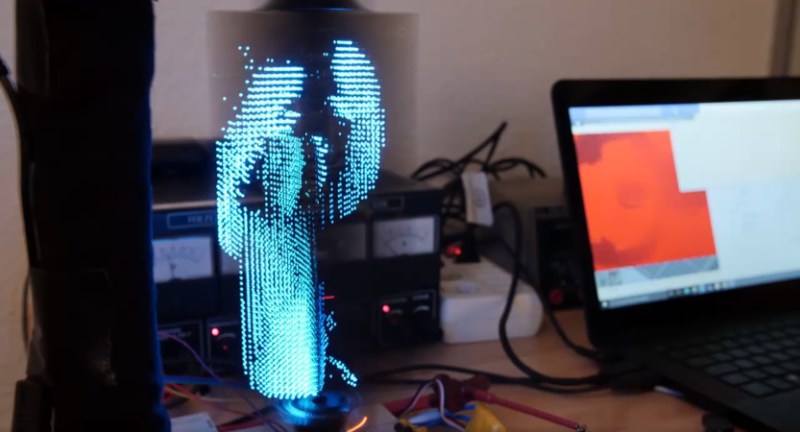Volumetric 3D displays that allow the viewing of full 3D images without special glasses are not unknown in our community, usually taking the form of either a 3D LED matrix or a spinning rotor either with an image projected onto it or holding an LED array. They are impressive projects, but they are often limited in what they can display. Pretty patterns and simple 3D models are all very well, but they are hardly 3D television. Thus we’re quite impressed with [Evlmnkey]’s bachelor’s degree project, which combines motion capture and a volumetric display for a genuine volumetric 3D closed-circuit television system.
Finding the details takes a bit of dredging through the Reddit thread, but the display is an off-the-shelf Adafruit single-sided LED matrix driven by an ESP32, all mounted on a motor with a pair of slip rings for power. Data is fed to the ESP via WiFi, with the PC responsible for grabbing the image sending it as uncompressed frames. There’s little detail on the 3D capture, but since he mentions a Kinect library we suspect that may be the source.
This is perhaps not the highest resolution TV you’ll ever have seen, indeed we’d liken it to the flickering 30 lines of 1930s mechanical TV, but it’s still a functioning volumetric 3D live CCTV system. If you’re interested by 3D displays, you might like to see our examination of the subject.
Thanks [nandkeypull] for the tip.
















Reminds me of an episode of sliders (TV series) that had a classroom with a 3D display in the ceiling. Showing DNA if memory serves.
The earlier seasons of Bones had a really cool volumetric display, but in real life it was just CGI done in post processing.
Wow, thanks for the feature, this is my project! Sorry for the missing write-up but it is this project (unfortunately pretty bare since I had to do a lot of writing-up for the thesis in german) : https://hackaday.io/project/171142-volumetric-pov-kinect-star-wars-holoprojector
Hopefully I’ll find the time to do a more detailed writeup soon. Thanks again :)
Thanks for that!
Now imagine replacing the LED matrix with a backlit TFT panel.
If that could be made to work, I think it would be quite impressive.
If you want impressive… think about a projector that uses a rotating or oscillating projection screen under a protective dome.
https://www.youtube.com/watch?v=-BlJDAHN4SQ
Nowhere is safe from the Wilhelm scream.
How about a transparent OLED display rotating?
JohnK
Sure, but it would be very dim
TFT panel’s refresh rate will be a limiting factor. Even the fancies gaming screen panels are capable of 360Hz max (vs this project’s 2000Hz).
Displaying an 3d picture at mere 10fps would leave you with only 36 frames / rotation, or 10 degrees per 3rd axis’s “pixel” which at only 2 cm from the center of rotation would be 3.5mm wide.
Spinning a hub75 display at high rpm? Not something I’d like to be in the same room as!
That kind of explains why we never tried this with old glass cathode ray tubes.
I have vague memories of a description of a circular phosphor screen being held upright and spun to sweep a spherical volume within an evacuated dome whilst being drawn on by CRT guns: 3D Tektronix-like line drawing and a low-res (but back then even 2D was low-res by current standards) 3D scan-line TV. Mono only, for obvious reasons. Circa 1966?
No idea what is was called or who is as trying it: hope it wasn’t just a fever dream.
And before anyone asks, the entire mechanical assembly was inside the glass vessel so only wiring needed to be brought outside!
I believe it’s this: https://youtu.be/7eM2K5qMugA
Using photophoretic traps:
https://www.youtube.com/watch?v=1aAx2uWcENc
Would be great in the classroom!
Help me Obi Wan..
Nice project!
Here is a volumetric display project from BYTE May 1978 that uses a rotating oblique mirror and an oscilloscope reflecting on that to generate the image:
“GRAPHICS IN DEPTH: 3-D Adds a New Dimension to Your Display”
https://archive.org/details/byte-magazine-1978-05/page/n15/mode/2up
Your one appears to have the benefit of a greater viewing angle by not having the projecting device get in the way of the viewer.